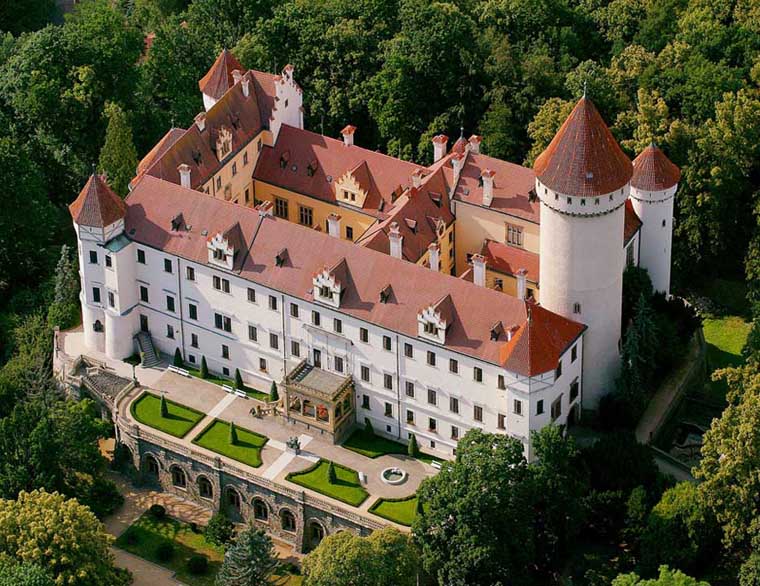Origins: A Medieval Stronghold
Konopiště Castle was founded in the late 13th century by Bishop Tobias of Benešov, a powerful figure in medieval Bohemia. Designed as a Gothic fortress, the castle was strategically located to guard trade routes and resist sieges. Its sturdy walls, defensive towers, and a deep moat made it nearly impenetrable during its early years.
The castle’s name, “Konopiště,” is derived from the Czech word for hemp (konopí), which was likely cultivated in the surrounding area.
Renaissance and Baroque Transformations
By the 16th century, the original Gothic structure began to evolve as new owners sought to modernize the castle. The Šternberk family, who acquired Konopiště in the late 1500s, undertook extensive renovations to transform the medieval fortress into a comfortable Renaissance residence. Ornamental gardens, elegant interiors, and decorative elements were added, reflecting the artistic trends of the time.
In the 18th century, the Vrtba family introduced Baroque-style enhancements, further softening the castle’s defensive appearance. During this period, the castle’s interiors were adorned with fine artworks, ornate furnishings, and intricate stucco designs, showcasing the wealth and sophistication of its noble occupants.
Archduke Franz Ferdinand: The Castle’s Most Famous Resident
The most notable chapter in Konopiště’s history began in 1887, when it was purchased by Archduke Franz Ferdinand of Austria, heir to the Austro-Hungarian throne. Franz Ferdinand fell in love with the castle’s idyllic surroundings and embarked on an ambitious project to restore it to its former glory.
Under his direction, Konopiště became a lavish royal residence. The Archduke installed modern amenities such as electricity, an elevator, and central heating, making it one of the most advanced estates of its time. He also filled the castle with his vast collection of hunting trophies, medieval weapons, and art, which remain on display today.
Konopiště was not just a home for Franz Ferdinand but also a retreat for his family. He shared the castle with his wife, Sophie, Duchess of Hohenberg, and their children, cherishing their private life away from the formalities of the Austro-Hungarian court.
The Assassination and World War I
Franz Ferdinand’s life at Konopiště was tragically cut short in 1914 when he and his wife were assassinated in Sarajevo. Their deaths set off a chain of events that led to World War I, forever changing the course of history. Following the war, the castle became part of the newly established Czechoslovakia.
Konopiště Castle Today
Today, Konopiště Castle is a popular tourist destination, attracting visitors with its stunning architecture, lush gardens, and historical significance. Guided tours offer a glimpse into the opulent lifestyle of Franz Ferdinand, showcasing his private chambers, armory, and hunting trophy collection—one of the largest in Europe.
The castle’s rose garden, originally designed by Franz Ferdinand himself, is a highlight for visitors, especially during the blooming season. The estate’s tranquil surroundings and historical charm make it a must-visit destination for history enthusiasts and travelers alike.
Conclusion
Konopiště Castle is more than just a beautiful building—it is a window into centuries of European history. From its origins as a medieval stronghold to its role as the residence of a pivotal historical figure, the castle encapsulates the rich cultural heritage of the Czech Republic. A visit to Konopiště is a journey through time, offering a deeper understanding of the events and people that shaped the world we know today.
Visit the Caste on our Private Day Trip to Konopiste Castle a wonderful place in the quiet serene forest setting.

